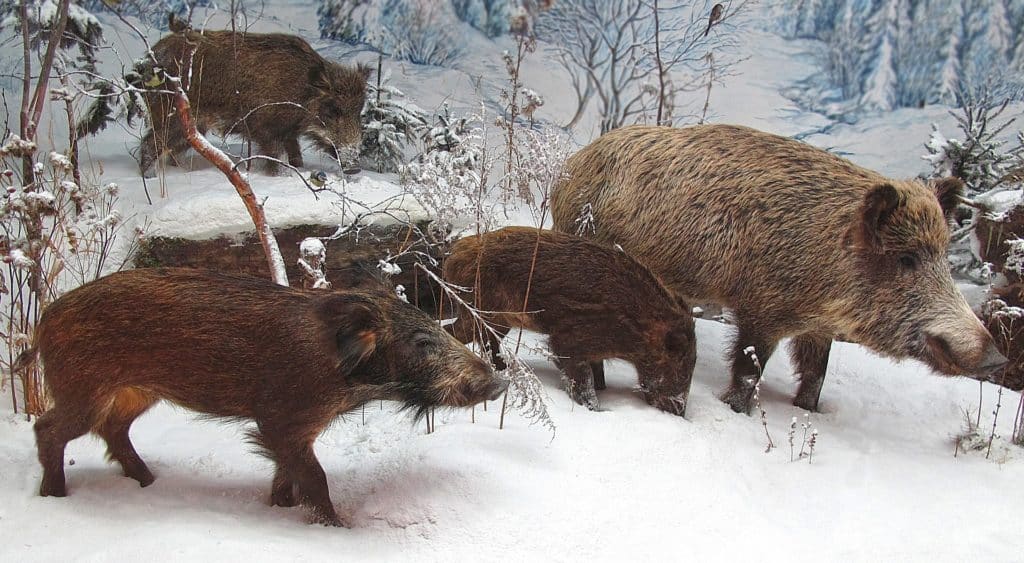5 Facts about Aujeszky's disease
- Veterinarian Mag.med.vet. Emin Jasarevic
- Updated: 2024-02-05
You want to know everything about Aujeszky's disease? In this guide, I'll explain all the facts and what you should definitely know about Aujeszky's virus. In addition, for this article we have Advice from veterinarian Mag.med.vet. Emin Jasarevic obtained. Note: This article is written for the german country.

What is Aujeszky's virus?
I love to take my dog for walks in the woods when we're in the country. Those are times when we can both really switch off on the weekend.
There she can let off steam properly, live out her primal instincts and remember her ancestors. Sporadically, there is a lot of sniffing.
There are smells and sensations that our dear dogs miss so much, just as humans do. We have forgotten many things in the age of big cities and technical comfort.
These moments in the forest and in the lap of Mother Nature are a journey into primal existence for both my furry nose and me.
Until I met a hunter on my walk. He pointed out to me that it would be better for my little one if I kept her on a leash. When I asked him why, he told me about the pseudo rage and how it is transmitted.
I never forget his words:
"You city people know that you should not feed your dogs with raw pork... Yes, do you also know that your dogs are directly confronted with the actual pathogen when they sniff uncontrolled in the forest here and there? My dear man, that happens in no time! ... Nature is not to be trifled with! ... Caution is better than indulgence!"
It was then that I first understood how unconsciously we as "conscious city people" sometimes act and think.
Even though I am not superstitious: The hunter was both a gift and a warning for me - like a guardian angel warning ahead...
Because no sooner had I tied my darling to her leash and walked on with her for a bit, than she started tugging: about two meters away to the right I saw a carrion of a forest animal...!
That very evening I started to think about the Pseudo rage to research. What I learned about it, I would like to share with you.
In the forest we both still very much like to go. But this time also accompanies us the pre-view 😉
What is pseudo-rage?
Aujeszky's disease (also known as Aujeszky's disease; pseudorabies; infectious bulbar paralysis; itch; mad itch) is caused by the Herpesvirus Suid Herpesvirus 1, SuHV-1 causes.
Hungarian veterinarian Aladár Aujeszky first described SuHV-1 in 1902, and it was not until the 1930s that researchers recognized it as the trigger of pseudowut and pigs as its natural host and vector.
Aujeszky's disease is a worldwide animal disease. Suspicion of Aujeszky in domestic swine and other domestic animals is notifiable.
However, the detection of Aujeszky's disease in feral pigs is not subject to notification or reporting. Nevertheless, the presence of this disease in feral pigs poses a threat to our domestic and domestic swine.
For example, in 2011, the first positive diagnoses were reported during an investigation in Lower Saxony.
Skateboarding virus infects the central nervous system and organs, such as the respiratory tract of mammals like dogs, cats, cattle, sheep or rabbits. In these so-called end hosts, the infection is always fatal. Humans and higher primates are excepted.
The main host - the pig - recovers after infection, but can still infect other animals with it. Excluded from this are piglets up to four weeks of age, they usually do not survive the disease.
Consequently, domestic and wild pigs are the only species that survive infection by this virus. Therefore, they also serve as the main host and vector. Domestic as well as wild pigs primarily develop transient respiratory symptoms when infected. However, in pregnant sows, the virus can cross the placenta, infect and kill the fetuses.
What is the situation in Germany?
Germany started an eradication program in 1989, which resulted in our country being has been officially SuHV-1 free since 2003.
However, this only applies to domestic pigs and not to wild boars. Accordingly, there is still a risk that other mammals can be infected by wild boar.
What are the transmission routes?
The virus is very resistant. It can survive for months at 4 °C, up to 40 days at 25 °C, thirty minutes at 56 °C, and about eight minutes at 80 °C. Inactivation of the virus only occurs above 55 °C.
The transfer is not tied to a season.
Dogs can get Aujeszky's disease, if they come into contact with infected, unheated or untreated pork.
Theoretically, the virus can also be transmitted through shoes and clothing. Therefore, transmission from the main host to the final host - in this case the dog - cannot be ruled out. However, the risk of infection also depends on the amount of virus. Infection through wild boar feces is also theoretically possible. Depending on the prevailing conditions, the virus may survive for a certain time outside the host. However, the probability is very low.
There are reports of transmission outside of host animals. However, no study has demonstrated that the virus is contagious in the wild environment.
The cases known so far in Europe are associated with wild boar killed during hunting and their organs or meat. Therefore, the probability of indirect infection is low.
An infection of a (hunting) dog through contact with infected blood of a wild boar may be good.
The virus is absorbed through the mucous membranes of the mouth and nose. Therefore, it is sufficient for infection if the potential end host has contact with the mucosa of an infected pig.
After the virus is absorbed through the mucous membranes of the mouth and nose, the pathogen enters the gastrointestinal tract. From there it goes to the nervous system and to the brain, brainstem and cranial nerve nuclei. Brain tissue is destroyed and failure of the nervous system occurs.
The incubation period is 2-9 days. This is the time between infection and outbreak of the disease. In many cases, this can be 3-5 days. Unfortunately, this disease is not treatable.
In addition, the treatment of this disease is prohibited by law. This is because it is a notifiable animal disease. For control, farmers and veterinarians must strictly follow the "Regulation for protection against Aujeszky's disease. hold
There is no vaccine against this virus. One to two days after the first symptoms appear, the infection ends in death.
What are the symptoms in dogs?
The symptoms of infection strongly resemble rabies. That is why this disease is also called pseudo rabies or pseudo rabies. In the Compared to rabies, dogs suffering from rabies develop aggressive behavior, are not thirsty and are water-shy, which is not or rather rarely the case with dogs suffering from Aujeszky.
After an infection, it quickly comes to a Inflammation of the brain and spinal cord, causing severe damage to the nervous system as well.
The most obvious sign of infection is the intense itching. The affected dog scratches or gnaws on the itchy areas so violently that it becomes very severe tissue injuries comes. The itching starts at the head area, especially at the ears and spreads to the whole body.
In addition Shortness of breath or Increased respiratory rate, difficulty swallowing, increased saliva production, diarrhea and vomiting. Apathy, loss of appetite and increased respiration. may occur. Many of the infected animals have a increased temperature of 41 °C.
Clouding of consciousness, convulsions and paralysis accompany the final stage of infection. Within 24 to a maximum of 48 hours, the dog ends up losing consciousness and dying.
The disease always ends in death in dogs and cats.
Unfortunately, a definite diagnosis can only be made after death, as the disease progresses very rapidly.
Contact your veterinarian immediately at the first signs! However, your vet can do nothing more for an infected dog. Except to put him out of his misery.
How can I avoid infection?
If you live in a rural area or like to take your furry friend on trips into the woods, then you should be especially careful. This is especially true if you like to go hunting.
All areas where feral hogs may be present are considered high-risk areas. Even though most regions of the EU are now considered epidemic-free, this means only domestic pigs.
Never let your dog get out of control, mainly when you take walks in forest areas. The risk of your charge coming into contact with an Aujeszky infected wild boar is too high. It's best to keep your furry companion on a leash.
You should also pay attention to this during your walks, that your darling does not come into contact with carrion or meat of hunted wild boar or their blood.
If you go hunting with your four-legged friend, pay attention, That he does not come into contact with gunshot wounds from a wild boar.
Do not feed your furbearer raw meat and offal from domestic or wild boar under any circumstances. Even a small amount of raw, infected meat can transmit the virus.
If you feed pork to your furry friend, be sure to boil or roast the pork thoroughly!
Frequently Asked Questions
Aujeszky's disease is a fatal viral infection transmitted by wild boars and domestic pigs as the main host. It is not contagious to humans, but to most mammals, including dogs and cats.
Aujeszyky's disease is mainly transmitted by pigs of any species. Your dog can become infected by eating raw pork or coming into contact with infected pigs. Wild boar carcasses in the forest can also be carriers.
Unfortunately, Aujeszky's disease is not curable. The vet can only end the suffering of your dog. Therefore, you must take good care that your dog does not get infected in the first place.
The symptoms of the infection strongly resemble rabies. That is why this disease is also called pseudo-rabies or pseudo-rabies. Compared to rabies, dogs that get rabies develop aggressive behavior, are not thirsty and are water-shy, which is not or rather rarely the case with Aujeszky infected dogs.
Never feed your dog raw pork. When walking in the forest, always make sure that your dog does not eat carrion. It is best to leave him on a leash and always under supervision.
Veterinarian’s Recommendation
Our territories and some EU countries are officially exempt from Aujeszky's disease.
We must not overlook the fact that these are only domestic pigs. The risk remains with feral hogs.
Here I would like to repeat the quotes of my guardian angel in hunter form:
"Foresight is better than hindsight!"
We must not forget that our four-legged friends face this risk, especially in areas with wild boars.
That's why:
Better to walk in a controlled way and with a leash!
Pork - whether wild or barn-raised - boil well!
Two tiny behavioral changes can make life persistently more enjoyable!
I hope to have helped you with my tips. If you are still looking for the right food for your pet, I recommend you to read in our detailed Dog food test to read.
If you prefer to cook for yourself, here are our 15 tips for Barf Beginners.

I am a veterinarian and writer on animal health topics. Animals are my passion, and it is my personal goal to create medically accurate articles and videos to educate pet owners as much as possible.
Share Now:

